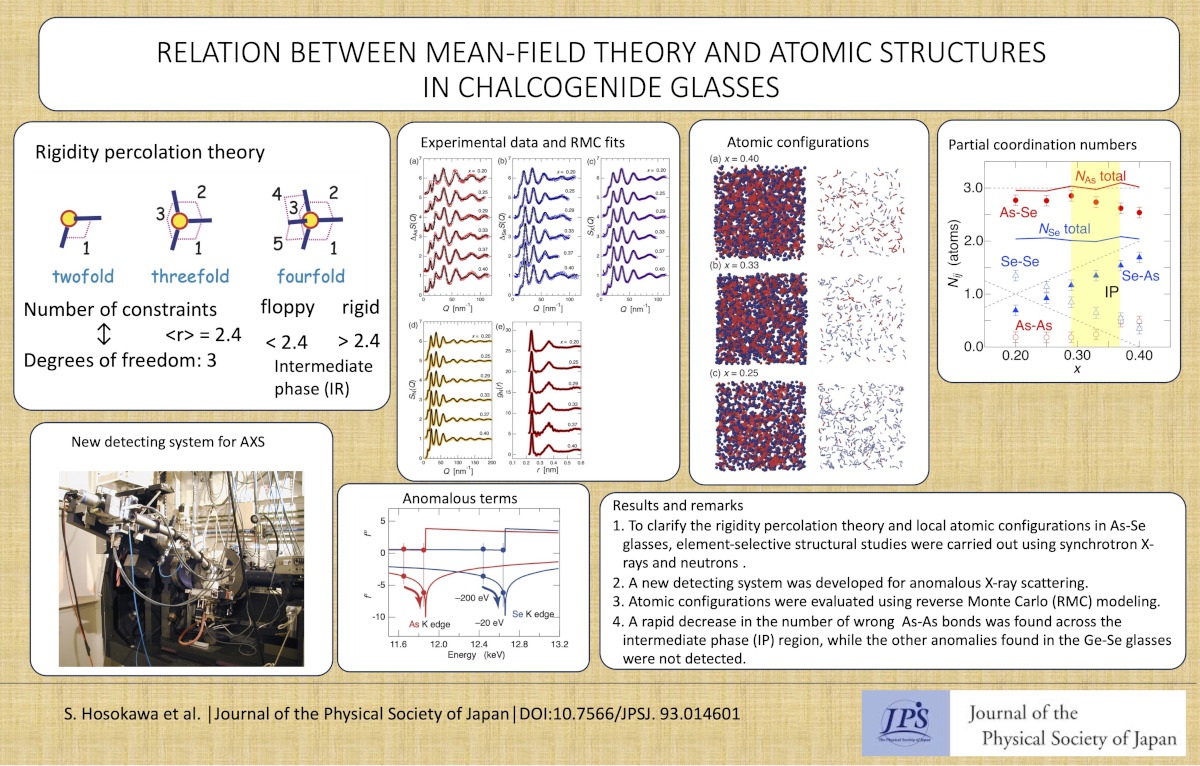Relation between Mean-Field Theory and Atomic Structures in Chalcogenide Glasses
© The Physical Society of Japan
This article is on
Local- and Intermediate-range Partial Structure Study of As-Se Glasses
J. Phys. Soc. Jpn. 93, 014601 (2024).
The authors conducted various of X-ray and neutron scattering experiments on typical chalcogenide glasses and clarified the relationship between the atomic structure and simple rigidity percolation theory.

Rigidity percolation (mean-field) theory is a simple theory that can explain several anomalies in the thermodynamic properties of covalently bonded glasses such as chalcogenides. According to this theory, the atoms in covalent glasses are constrained by either bonds or bond angles. When the constituent atom has coordination number r, the bond constraint and bond angle constraint are r/2 and 2r-3 per atom, respectively. If the averaged sum of these constraints is equal to the degree of freedom of three in three dimensions, i.e., r = 2.4 at x = 0.40 for AsxSe1-x glasses and x = 0.20 for GexSe1-x glasses, the glasses show excellent glass forming ability separated between rigid (r > 2.4) and floppy (r < 2.4) glasses. Further, calorimetric and Raman scattering experiments revealed that the transition occurred within a certain composition range of the intermediate phase (IP) of the unstressed rigid phase.
This article presents a series of structural studies using element-selective diffraction techniques with synchrotron X-rays and high-flux neutron sources to investigate the structural changes across the IP transition phase in chalcogenide glasses. Technical improvements were achieved by developing a new detection system with a curved graphite analyzer crystal and a 1-m-long detector arm at the beamline BM02 of the European Synchrotron Radiation Facility (ESRF). Experimental X-ray and neutron diffraction data and anomalous X-ray scattering (AXS) results close to the absorption edges of the constituent elements were analyzed using reverse Monte Carlo modeling to reveal changes in intermediate-range atomic configurations across the IP range from rigid to floppy. The AsxSe1-x glasses have an IP range of x = 0.29-0.37, where a rapid decrease in the number of wrong As-As bonds is observed. However, other anomalies found in Ge-Se glasses were not clearly observed, such as a rapid decrease in the pre-shoulder positions in the Se-Se partial structure factor, SSeSe(Q), a rapid decrease in the number of edge-sharing connections, and an exclusion tendency of the connections between the As (Ge) atoms sharing two Se atoms. These differences may be related to the anisotropic pyramidal AsSe3 units in the As-Se glasses, in contrast to the isotropic tetrahedral GeSe4 units around the Ge atoms in the Ge-Se glasses. This study was supported by a JSPS Grant-in-Aid for Transformative Research Areas (A) Hyper-Ordered Structures Science.
(Written by S. Hosokawa on behalf of all the authors.)
Local- and Intermediate-range Partial Structure Study of As-Se Glasses
J. Phys. Soc. Jpn. 93, 014601 (2024).
Share this topic
Fields
Related Articles
-
Evaluation of the Exchange Stiffness Constants of Itinerant Magnets from the First-Principles Calculations
Electron states in condensed matter
Structure and mechanical and thermal properties in condensed matter
2024-6-5
Using first-principles calculations, we evaluated the exchange stiffness constants of ferromagnetic metals at finite temperatures. The constants can be used as parameters in the Landau–Lifshitz–Gilbert equation.
-
Which is Moving?—Pinning Down the Origin of Fluctuations in Muon Spin Relaxation—
Structure and mechanical and thermal properties in condensed matter
Cross-disciplinary physics and related areas of science and technology
2024-3-28
The study demonstrated that we can distinguish between the diffusion motion of the muon itself and the motion of the surrounding ions in muon spin relaxation.
-
Variety of Mechanically Induced Spin Currents in Rashba Systems
Electronic transport in condensed matter
Magnetic properties in condensed matter
Structure and mechanical and thermal properties in condensed matter
2024-3-22
Various types of spin currents, including unconventional types, are generated in Rashba spin-orbit coupled systems by dynamic lattice distortions associated with, for example, surface acoustic waves.
-
Possible Origin of High Thermoelectric Power Factor in Ultrathin FeSe: A Two-band Model
Electronic structure and electrical properties of surfaces and nanostructures
Structure and mechanical and thermal properties in condensed matter
Cross-disciplinary physics and related areas of science and technology
2023-12-21
The high thermoelectric power factor observed in ultrathin FeSe can be theoretically explained by a two-band model with chemical potential between upper and lower band bottoms.
-
Exploring Recent Advances in the Physics of Biofluid Locomotion
Measurement, instrumentation, and techniques
Cross-disciplinary physics and related areas of science and technology
Electromagnetism, optics, acoustics, heat transfer, and classical and fluid mechanics
Statistical physics and thermodynamics
Mathematical methods, classical and quantum physics, relativity, gravitation, numerical simulation, computational modeling
Structure and mechanical and thermal properties in condensed matter
2023-12-8
This Special Topics Edition of the JPSJ describes the latest advances in the field of biofluid locomotion, shedding light on the underlying physics behind the movement of organisms that swim and fly.
